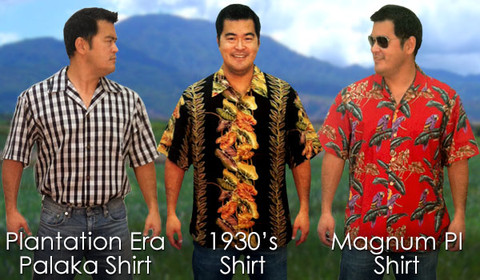
| Reference Article 2 | |
| The colorful history of Hawaiian shirts | |
 Hawaiian shirts, most often referred to as Aloha shirts in Hawaii, originated there in the early 1930s, designed and produced by Ellery Chun, a Waikiki merchant. He found himself with a surplus of old kimono fabrics and Ellery decided to fashion shirts from the kimono fabrics, which could be sold to the visiting tourists and military stationed on the island. The local newspaper in Honolulu (Honolulu Advertiser) began calling them Aloha shirts, and Chun was quick to register and trademark the name. Very soon, Chun had neither shirts nor surplus fabric, as locals and tourists alike descended upon his store and bought his entire stock. His unique contribution to Hawaiian apparel was an immediate hit and its popularity has since spread around the world. Chun, unfortunately, enjoyed a limited portion of the success, as within a few short years, Aloha shirts were being mass produced by several major design labels such as Surf n Sand, Shaeen, Kahala and more. Most of that production was marketed as Hawaiian shirts (which is what they are called by people living on the mainland), to avoid trademark infringement. When World War II was over, the tourist trade in Hawaii began to grow very rapidly, and by 1959, when Hawaii became a state, essentially every tourist sported a Hawaiian shirt. As a result, the shirts’ popularity gradually spread to California, as surfers quickly embraced them as a part of their own sub-culture. Meanwhile, back in the Islands, the Aloha shirt had become synonymous with Hawaiian in another way. Through common usage, relaxing business dress standards and organized movements, the more formal business dress of shirt, tie and jacket were replaced with this colorful new icon of Hawaiian culture. “Casual Friday”, a practice in many businesses in the mainland U.S., actually has its origins in “Aloha Friday”, which was the day that many Hawaiian businesses and offices allowed Aloha shirts to be worn by employees. Those efforts to make the Aloha shirt official attire of Hawaii had their roots in the Honolulu Chamber of Commerce and the Hawaii Senate. Today, however, Hawaiian style shirts are considered appropriate dress for all but the most formal of events, and are considered appropriate business attire for any setting or day of the week. Client calls, business conferences and seminars, court appearances, as well as weddings and funerals… all will see many such shirts in the crowd. The average kama`aina (native-Hawaiian or long-time resident) typically won’t wear the brightly colored shirts that many of us are used to seeing at the airport. They tend to prefer somewhat subdued colors and prints, most often either floral or of a Polynesian motif, and often in a reverse print. Reverse print is sewing the fabric in a way that places the prominently printed side on the inside of the garment, which gives the impression the shirt is being worn inside-out. The typical malihini (newcomer or visitor) is often to be found wearing the less sedate prints, which sometimes are comprised of non-traditional images, such as sea creatures, automobiles or sports team logos - the possibilities being virtually unlimited. Some companies, both in the Islands and the mainland U.S., have even commissioned “uniform” shirts for their employees, sporting the company logo or products. Trader Joe’s, for instance, has weaved the the Aloha shirt into their dress code for employees. In addition to the cultural aspect of this relatively new Hawaiian apparel item (forty years is a very short time, in the context of Hawaii’s rich history), it is extremely practical wear. Somewhat similar in concept to the guayabera of Mexico, Cuba, the Philippines and other countries with heavy Spanish influence, Hawaiian shirts are especially comfortable in tropical climates, where loose-fitting clothing is preferable. Aloha shirts are often the clothing of choice for men that conceal carry firearms as they tend to not "imprint". The Hawaiian version, however, usually has only pocket on the left breast, while the guayabera has two or four pockets, as well as front and back pleats, which the Aloha shirt doesn’t have. The mu’umu’u (a long and loose fitting dress), is another form of popular Hawaiian apparel, often worn by women, although women often also wear the shirts. The prints are similar, and it’s not uncommon to see couples wear matching prints. Some women also opt for the shorter Hawaiian dresses or tank dresses, both of which are sleeveless. While there are many local and mainland suppliers of Hawaiian apparel, manufacturers those whose clothing is made in the Islands or the mainland U.S., rather than made in Asia, are considered to be “authentic” and are generally of higher quality. In today’s global market, it’s sometimes difficult to source authentic products, but if you intend to wear a Hawaiian shirt or any other item of Hawaiian apparel, wouldn’t you rather it actually be Hawaiian, rather than “Made in China”? |
|